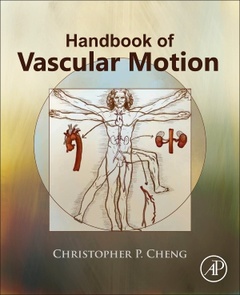Description
Handbook of Vascular Motion
Author: Cheng Christopher
Language: English
Subjects for Handbook of Vascular Motion:
Keywords
Abdominal aorta; Adverse events; Aortic aneurysm; Aortic arch; Aortic dissection; Aortic length; Aortic strain; Arm abduction/adduction; Arterial angulation; Arterial curvature; Arterial strain; Ascending aorta; Axial deformation; Axial length; Axial twist; Azygous vein; Basilar artery; Basilar artery aneurysm; Bending; Bifurcation angle; Biomechanics; Body posture; Boundary conditions; Branch angle; Cardiac and respiratory deformation; Cardiac gating; Cardiovascular; Carotid artery; Centerline; Central lines; Circumferential strain; Clinical decision-making; Clinical sequelae; Clinical trial; Cobalt–chromium; Computed tomography; Contrast agents; Coregistration; Coronary; Coronary arteries; Cross-sectional; Curvature; Cycle count; Deformation; Delivery procedure; Descending thoracic aorta; Design control; Design verification; Device design; Device durability; Diagnostics; Dialysis; Diametric; Diametric compression; Diametric deformation; Durability; Duty cycle; Dynamic imaging; Endografts; Endoleak; Endovascular aortic repair; FDA; Fatigue testing; Femoral artery; Femoral veins; Femoropopliteal; Femoropopliteal artery; Fiducial markers; Finite element analysis; Fracture; Fracture mechanics; Geometric modeling; Heart valve; Iliac artery; Iliac veins; Image processing; Imaging protocols; Inferior vena cava; Inferior vena cava filter; Iteration; Jugular vein; Left anterior descending artery; Left circumflex artery; Level set; Longitudinal motion; Longitudinal strain; Magnetic resonance imaging; May–Thurner; Mechanical durability; Mechanical evaluation; Mechanobiology; Median arcuate ligament syndrome; Medical devices; Medical imaging; Motion; Multiaxial; Multimodal; Myocardial deformation; Nitinol; Nutcracker syndrome
410 p. · 19x23.3 cm · Paperback
Description
/li>Contents
/li>Biography
/li>Comment
/li>
Handbook of Vascular Motion provides a comprehensive review of the strategies and methods to quantify vascular motion and deformations relevant for cardiovascular device design and mechanical durability evaluation. It also explains the current state of knowledge of vascular beds that are particularly important for the medical device industry. Finally, it explores the application of vascular motion to computational simulations, benchtop testing and fatigue analysis, as well as further implications on clinical outcomes, product development and business.
1. Introduction
Part I Methods for Quantifying Vascular Deformations2. Deciding What You Need and How to Get It3. Medical Imaging Modalities and Protocols4. Geometric Modeling5. Centerline Deformation Metrics6. Surface Deformation Metrics
Part II Deformations of Vascular Beds Relevant for Medical Devices7. Coronary Blood Vessels8. Neurovascular Blood Vessels9. Thoracic Aorta and Arch Branches10. Abdominal Aorta and Visceral Arteries11. Lower Extremity Arteries12. Inferior Vena Cava and Lower Extremity Veins13. Upper Extremity Blood Vessels
Part III Developing and Utilizing Boundary Conditions14. Developing Boundary Conditions for Durability Evaluation15. Summary of Durability Evaluation Methods16. How to Improve Durability in a Pinch17. Areas of Future Research18. Conclusions
- PROSE Book Award Nominee in the "Single Volume Reference Book" category
- Describes methods to quantify vascular motion and deformations including choosing what data to collect, relevant medical imaging, image processing, geometric modeling, and deformation quantification techniques
- Includes deformations for vascular beds of particular importance in medical devices including the coronary arteries and heart, arteries of the head and neck, thoracic aorta and arch branches, abdominal aorta and visceral branches, lower extremity arteries, inferior vena cava, and lower extremity veins
- Explains how to convert raw deformations into boundary conditions suitable for durability evaluation, provides examples of using this information for computational simulations, benchtop testing, and fatigue analysis, and illustrates examples of how vascular motion affect clinical outcomes, product development, and business



